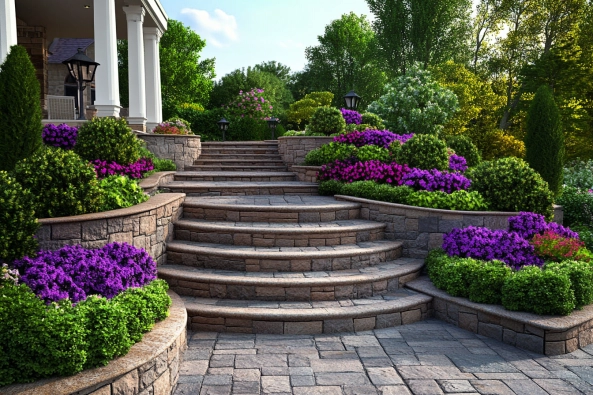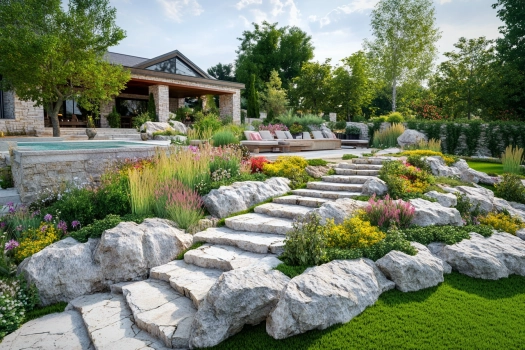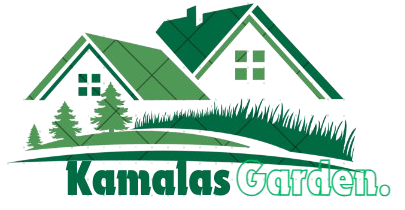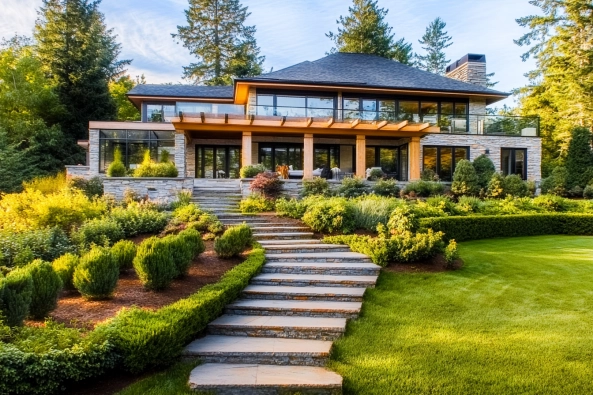Why Landscaping a Sloped Yard is Important
A sloped yard may seem challenging to design and maintain, but with the right landscaping techniques, it can become a stunning and functional outdoor space. Hillside landscaping enhances beauty, improves usability, and prevents erosion.
Benefits of Hillside Landscaping
- Erosion Control: Proper landscaping prevents soil erosion and water runoff.
- Maximizing Usable Space: Terraces and pathways make sloped areas functional.
- Enhanced Curb Appeal: Well-designed hillsides boost property value and aesthetic appeal.
Challenges of Sloped Yards & How to Overcome Them
- Soil Erosion: Use retaining walls, ground cover plants, and proper drainage solutions.
- Difficult Access: Add pathways, steps, and terraces to navigate the yard safely.
- Water Drainage Issues: Dry creek beds and French drains help redirect excess water.
Best Practices for Maintaining a Sloped Garden
- Use drought-tolerant plants to minimize watering needs.
- Install drip irrigation for controlled moisture delivery.
- Mulch exposed soil to retain moisture and reduce erosion.
10 Hillside Landscaping Ideas for a Stunning & Functional Yard
1. Create Terraced Levels for Usable Space

Terracing transforms a steep slope into flat, usable spaces for gardening, seating, or pathways.
Benefits of Terracing:
- Prevents soil erosion and runoff.
- Creates flat, functional spaces.
- Allows for layered planting.
Best Materials for Building Terraces:
- Stone: Natural and durable.
- Wood: Cost-effective and blends with nature.
- Concrete Blocks: Sturdy and low-maintenance.
Step-by-Step Guide to DIY Terracing:
- Mark out terrace levels.
- Dig back into the slope to create flat sections.
- Install retaining walls for support.
- Plant erosion-controlling plants along terrace edges.
2. Build a Natural Stone or Gravel Pathway
Pathways offer safe access while adding structure to your landscape.
How Pathways Prevent Soil Erosion:
- Directs foot traffic to prevent soil displacement.
- Allows controlled water drainage.
Best Materials for Hillside Walkways:
- Gravel: Budget-friendly and easy to install.
- Flagstone: Natural and slip-resistant.
- Stepping Stones: Rustic and visually appealing.
Creative Design Ideas for Winding Paths:
- Curved pathways for a natural, meandering look.
- Integrate solar lighting along the edges.
- Use different stone colors and textures for contrast.
3. Install Stone Slab Steps for Safe Access
Stone steps provide stability and enhance the visual appeal of your yard.
Choosing the Right Size and Placement for Stairs:
- Opt for wide, deep steps to accommodate foot traffic.
- Use gravel or compacted sand as a base for stability.
DIY vs. Professional Installation Tips:
- DIY for small slopes using pre-cut stone slabs.
- Hire professionals for steep or complex projects.
4. Use Retaining Walls for Stability & Aesthetics
Retaining walls hold back soil, reduce erosion, and define garden spaces.
Types of Retaining Walls:
- Stone Walls: Natural and long-lasting.
- Concrete Blocks: Sturdy and cost-effective.
- Gabion Walls: Wire cages filled with rocks for a modern look.
How to Build a Retaining Wall:
- Dig a trench and lay a strong foundation.
- Stack materials in staggered layers.
- Install drainage behind the wall to prevent water buildup.
5. Design a Hillside Rock Garden

A rock garden is an attractive, low-maintenance solution for sloped yards.
Best Drought-Resistant Plants for Rock Gardens:
- Sedum
- Creeping Phlox
- Yucca
How to Use Boulders and Stones for a Natural Look:
- Group large rocks for a layered effect.
- Use different sizes and colors for visual contrast.
- Fill gaps with small pebbles and ground cover plants.
6. Create a Dry Creek Bed for Drainage
A dry creek bed channels excess water and adds beauty to the landscape.
How Dry Creek Beds Prevent Erosion:
- Directs rainwater runoff safely.
- Reduces soil displacement on slopes.
Best Stones and Plants for a Functional Creek Bed:
- River rocks for a natural water-like appearance.
- Drought-tolerant grasses along the edges.
- Small boulders for structural support.
7. Add a Water Feature for a Stunning Focal Point
Water features make sloped yards more dynamic and visually appealing.
Best Water Features for Sloped Landscapes:
- Cascading waterfalls.
- Small pond at the bottom of a slope.
- Natural stream beds for a woodland feel.
Maintenance Tips for Hillside Water Features:
- Use energy-efficient pumps.
- Regularly clear debris to prevent clogs.
- Choose algae-resistant materials.
8. Plant Native and Drought-Tolerant Plants for Erosion Control
Proper planting enhances the beauty and stability of a sloped yard.
Best Ground Cover Plants for Slopes:
- Creeping Juniper
- Vinca
- Sedum
Using Shrubs and Trees for Stability:
- Plant deep-rooted shrubs like rosemary or cotoneaster.
- Use trees with wide root systems, like oak or maple.
9. Install Outdoor Lighting to Highlight Your Hillside Design
Lighting enhances safety and creates a cozy ambiance.
Best Types of Landscape Lighting for Slopes:
- Pathway Lights: Guide movement safely.
- Uplighting: Highlights trees and retaining walls.
- Solar-Powered Options: Eco-friendly and cost-effective.
10. Build a Cozy Seating or Fire Pit Area
A seating area transforms a sloped yard into a relaxing retreat.
Best Materials for Fire Pits and Seating Walls:
- Brick or stone for durability.
- Gravel flooring for easy maintenance.
How to Create Level Seating Areas:
- Build small terraces for seating zones.
- Install a paver patio for a sturdy surface.
Tips for Maintaining a Hillside Landscape
Preventing Soil Erosion with Proper Drainage Solutions
- Install French drains or perforated pipes.
- Use ground covers and deep-rooted plants.
Seasonal Care for Plants and Hardscape Elements
- Prune plants before winter to maintain shape.
- Check retaining walls for cracks or movement.
Budget-Friendly Ways to Maintain a Sloped Yard
- Use free or repurposed stones for pathways.
- Choose low-maintenance perennials.
Common Mistakes to Avoid in Hillside Landscaping
Overlooking Drainage Issues
- Always test water flow patterns before landscaping.
Choosing the Wrong Plants for Steep Slopes
- Avoid shallow-rooted plants that can’t anchor soil.
Failing to Reinforce Pathways and Terraces
- Secure edges with stones or treated wood.
Conclusion: Transform Your Sloped Yard with These Stunning Ideas
With the right techniques, a sloped yard can be both beautiful and functional. Whether you use terracing, pathways, rock gardens, or water features, you can create a landscape that prevents erosion while adding stunning visual appeal.
Related Posts You May Like
For more inspiration, check out these sloped yard landscaping ideas.

